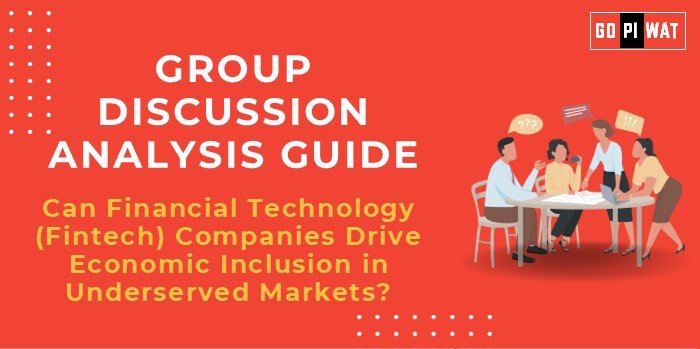📋 Group Discussion (GD) Analysis Guide: Can Financial Technology (Fintech) Companies Drive Economic Inclusion in Underserved Markets?
🌐 Introduction to the Topic
Opening Context: Globally, fintech is emerging as a powerful tool to bridge economic disparities, especially in underserved markets. In countries like India, where over 190 million adults remain unbanked, the potential of fintech for financial inclusion is unparalleled.
Topic Background: Fintech companies leverage technology to provide accessible and affordable financial services. These services include digital payments, microloans, and insurtech, with significant impact in developing economies. The ongoing digital revolution further enhances the potential of fintech to transform lives.
📊 Quick Facts and Key Statistics
- 🌍 Global Unbanked Population: 1.4 billion people, with over 50% in developing nations (World Bank, 2023).
- 📱 Digital Payment Users: Over 1.3 billion worldwide, showcasing fintech’s rapid adoption.
- 🇮🇳 India’s Fintech Adoption Rate: 87%—second highest globally (EY Fintech Index 2023).
- 🔄 UPI Monthly Transactions: 11.5 billion, demonstrating fintech’s mass accessibility in India.
🧑🤝🧑 Stakeholders and Their Roles
- 🏛️ Governments: Establish regulatory frameworks and financial literacy programs.
- 🏢 Fintech Companies: Develop innovative solutions for underserved populations.
- 🏦 Traditional Banks: Collaborate with fintech firms for last-mile service delivery.
- 🌍 International Organizations: Provide funding and policy recommendations for scaling fintech solutions.
🏆 Achievements and Challenges
🎯 Achievements:
- Financial Inclusion: Digital wallets and UPI have brought millions into the formal banking system.
- Microloans and Credit Access: Platforms like Kiva and LendingKart are empowering small businesses.
- Cost-Effective Solutions: Reduction in transaction costs by up to 80% due to digital systems (BCG Report, 2024).
- Global Success Story: M-Pesa in Kenya transformed mobile banking by integrating savings and credit.
⚠️ Challenges:
- Digital Divide: Limited access to smartphones and the internet in rural areas.
- Cybersecurity Threats: Rising cases of data breaches (e.g., AIIMS attack in India).
- Regulatory Uncertainty: Varied global approaches to fintech regulation, affecting scalability.
Global Comparisons:
• Success: Kenya’s M-Pesa reaching 50% of the adult population.
• Challenges: Lack of interoperability in many African markets.
📋 Structured Arguments for Discussion
- Supporting Stance: “Fintech is a transformative force enabling inclusive growth in underserved regions through cost-effective and scalable solutions.”
- Opposing Stance: “Without addressing the digital divide and cybersecurity, fintech’s benefits remain inaccessible to the most vulnerable.”
- Balanced Perspective: “While fintech has immense potential, realizing its full benefits requires a focus on accessibility, security, and regulation.”
💬 Effective Discussion Approaches
- 💡 Opening Approaches:
- “With 87% fintech adoption, India shows how digital solutions can transform financial inclusion for billions.”
- “While digital transactions are growing, only 20% of rural households have stable internet access.”
- 💡 Counter-Argument Handling:
- Recognize limitations, e.g., rural connectivity, and suggest solutions like satellite internet for last-mile access.
📈 Strategic Analysis of Strengths and Weaknesses
Strengths:
- High scalability.
- Cost efficiency.
- Innovative models (e.g., P2P lending).
Weaknesses:
- Infrastructure gaps.
- Data security risks.
Opportunities:
- Expansion in rural areas.
- Partnerships with telecom providers.
Threats:
- Regulatory hurdles.
- Lack of user trust.
📚 Connecting with B-School Applications
- Real-World Applications: Strategy formulation for fintech growth in emerging markets.
- Sample Interview Questions:
- 🧐 “How can fintech companies address the urban-rural divide in India?”
- 📘 “Evaluate the role of regulation in fostering fintech innovation.”
- Insights for Students: Understanding fintech’s role in ESG (Environmental, Social, Governance) criteria and inclusive growth.


